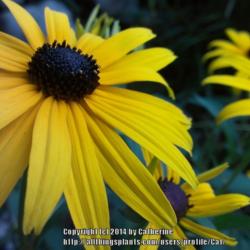The most common form of Black Eyed Susan and usually available in any local nursery. Goldfinches will eat the dried seeds from the seedheads if you do not cut them.

Rudbeckia fulgida is a nectar source for monarchs and other butterflies and a Monarch Way Station plant.

Although some sources might call this plant a perennial, it didn't perform well for me as such. Wintersown, mine bloomed well and displayed beautiful color in their first summer. They thrived. A few did survive that first winter in my yard but never thrived after that. In their second year their blossom color was muted and the plants seemed weak. They were barely visible in my garden.

I see some Green-headed or Cutleaf Coneflowers in scattered areas of meadow and woodland edges in the wild of southeast Pennsylvania in well-drained or draining wet soils. I've seen it in a few gardens also. Some are sold by larger, diverse conventional nurseries or native plant nurseries. It blooms in July into September and is a good pollinator plant. Its native range is from Quebec to Montana south to Arizona to Florida.

Taller, bigger flowers, and more stately than Rudbeckia fulgida. Looks great paired with Echinacea, especially Magnus, which is a similar height. Seeds need to be cold treated, so this plant is great for winter sowing.

Original plant was found about 30 miles south of where we live. Introduced in 2003.

These are considered a short-lived perennial. They will sometimes make it through a few winters and might reseed themselves. Sometimes treated as annuals. I've started them from seed a few times and they've never come back for me in my zone 5 garden.

Self-seeds and readily crosses with other Rudbeckias. Resultant presentation is a yearly surprise.

It's time to cut the dried cones after they flowered all of April and May. Cutting these 1st seed heads encourages the plants to make a 2nd flush of flowers in late summer/fall. I also will be planting some of these seeds for late summer/fall sprouts of new plants for some friends and family to have flowers next spring.

Rudbeckia 'Little Goldstar' is a relatively new Black Eyed Susan that was introduced by Jelitto Seeds in 2011.
